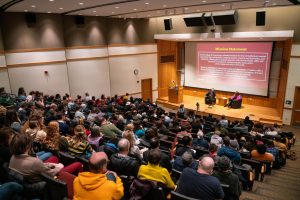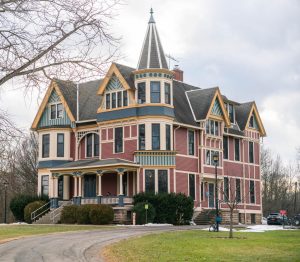Professors Shed Light on Chamber Music Experience
February 27, 2015
As an ensemble, soloists and professors Amir Eldan, Haewon Song and David Bowlin are a force with which to be reckoned. On Wednesday Feb. 18 the Oberlin Trio — comprised of the cellist, pianist and violinist, respectively — offered a dynamic and powerful performance that showcased works by Haydn, Shostakovich and Dvorak. The trio, which performs throughout the year and was included as part of the chamber music intensive during Winter Term, gives students a fresh perspective on the musical capabilities of their teachers and chamber coaches. Furthermore, students can better grasp what it’s like to perform with a professional chamber ensemble by watching their own instructors cohesively engage in aesthetically unique pieces.
First on the program was Piano Trio No. 39 in G Major by prolific classical composer Joseph Haydn. Bowlin began with an elegant descending melody — the main motivic idea of the first move
ment. Eldan provided a bass line and countermelody, atop which Bowlin moved delicately. Song’s playing showcased her especially tasteful touch at the piano, which was well suited to Haydn’s style. The trio’s balance was flawless. After accidentally forgetting to remove his mute before beginning the first movement, Bowlin exchanged a smile with Eldar before continuing the program. The small shared moment added a comforting light-heartedness and humor to Haydn’s already playful repertoire. The second movement was especially touching. Bowlin and Song bore the bulk of the melody while Eldan thickened the sound texture with a low, unhurried bass line. The movement resolved peacefully before the third and final movement erupted enthusiastically. The rondo finale provided a lively and exciting contrast to the gentler first two movements.
In the second piece, the trio jumped forward nearly 150 years to the great Russian composer Dmitri Shostakovich. Shostakovich wrote Trio No.2inEMinorin1944in memory of a close musician friend named Ivan Sollertinsky who had passed away. The piece began with Eldan playing complex harmonics in the extreme upper range of the cello and developed into a slower, introspective theme. Bowlin soon joined into the fugue, followed by Song playing in the lowest range of the piano. At first, the contrasting timbre and range was hard on the ear, but the musicians attained musical unity as the piece progressed.
Despite a slow beginning, the increasing tempo emphasized Shostakovich’s Russian style. Bowlin maneuvered the extremely technical passages of the movement with great facility, while Song and Eldan provided a continuously driving eighth-note pattern. Each movement had clear contrasting character: the second movement was jaunty while the third movement was somber, with Eldan and Bowlin exchanging slow melodies amid a constantly driving piano. The final movement introduced a famous Shostakovich theme, which he later quoted in many of his other pieces. The piano began the theme, which the entire ensemble ultimately played in unison. The piece dwindled to a somber and melancholic ending as the texture thinned and the voices grew further apart again. The final chords were reminiscent of the opening to the first movement, and the music slowly died away with delicate pizzicatos and low piano chords.
Antonin Dvorak’s Trio in E Minor, Op. 90, “Dumky Trio,” one of the most well known pieces in the trio’s repertoire, was reserved for the second half of the program. The piece, whose name is derived from a Slavic word referring to epic ballads, is one of Dvorak’s most well-known chamber works. As a form, a dumka — singular of dumky — is a large, introspective composition interspersed with energetic and cheerful sections.
Eldan began dramatically with powerful notes, to which Song responded with a descending motif. The movement alternated moods, from soft and delicate to thrilling and animated. The second movement began with a delightful piano melody, which the strings joined with impeccable intonation and clarity of sound. The music swelled to a dramatic tutti melody before dying away and introducing new melodic ideas. Dvorak’s folk-like musical language was especially evident in this movement and came to a climactic finish with a soft pizzicato from Bowlin.
The final three movements flowed seamlessly and offered stark contrasts in sound and timbre, which the Oberlin Trio handled easily. From the dramatic opening of the first movement to the jubilant final chords, the Oberlin Trio performed admirably, with flawless intonation and communication. The concert offered a variety of musical styles, from Haydn’s lighter style to Shostakovich’s intensely atmospheric sound and finally Dvorak’s melodic work. The Oberlin Trio cemented their stellar reputation with each successive piece and left the audience excited for future performances.

























